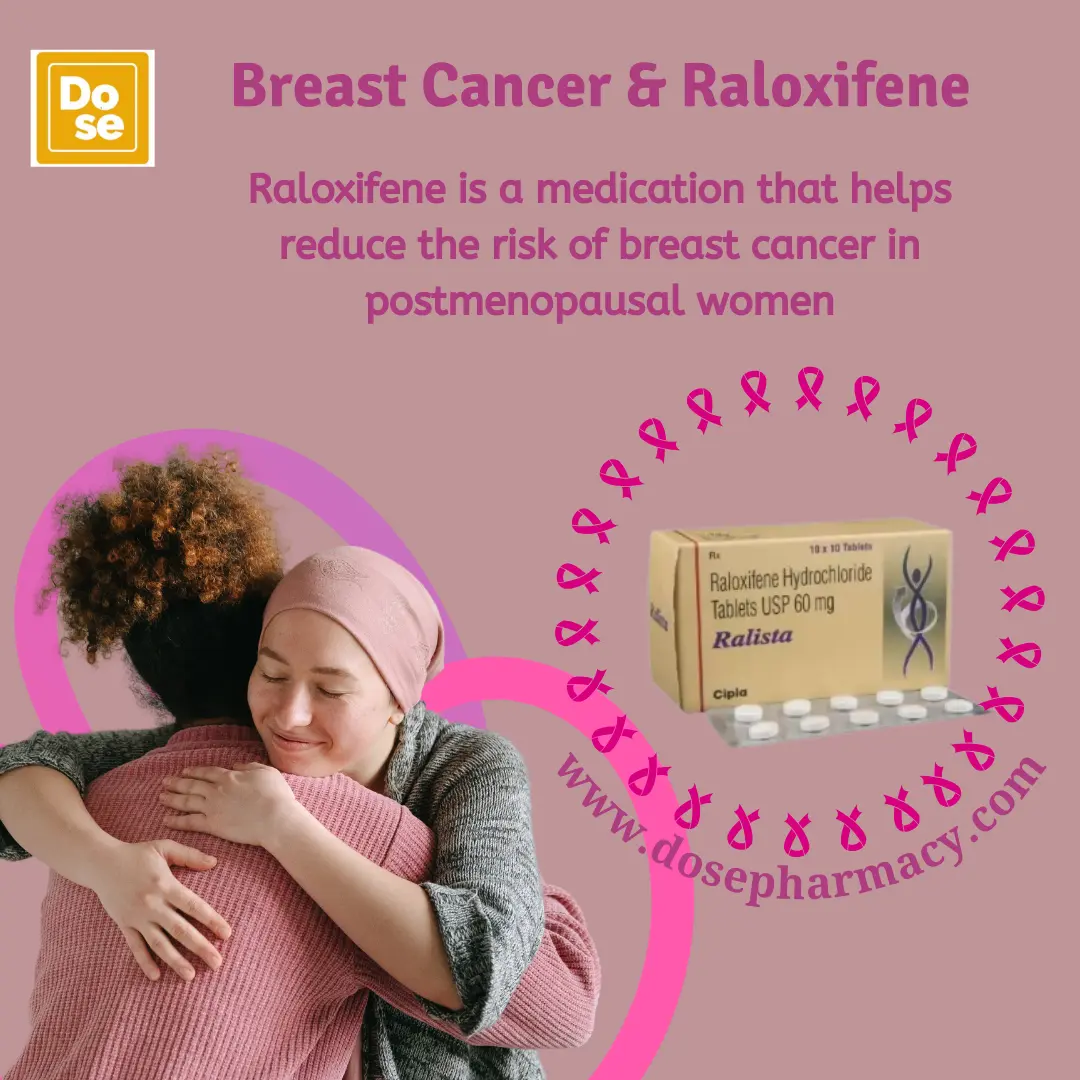Breast cancer remains one of the leading causes of cancer-related deaths among women worldwide. While significant advances in treatment have improved survival rates, the focus has also shifted toward prevention. One promising option in the prevention and management of breast cancer is raloxifene, a selective estrogen receptor modulator (SERM). Originally developed for osteoporosis treatment, raloxifene has demonstrated efficacy in reducing the risk of hormone-positive breast cancer in postmenopausal women. you can Buy Raloxifene from Dose Pharmacy. This article explores the role of raloxifene in breast cancer treatment and prevention, its mechanism of action, benefits, potential risks, and suitability for different patient groups.
Understanding Raloxifene
Raloxifene is a selective estrogen receptor modulator (SERM) that exhibits both estrogen-like and anti-estrogenic effects depending on the target tissue:
- In bones, raloxifene acts as an estrogen agonist, promoting bone density and reducing the risk of fractures in postmenopausal women.
- In breast tissue, raloxifene acts as an estrogen antagonist, blocking estrogen receptors and preventing estrogen-driven tumor growth.
This dual action makes raloxifene a valuable medication for both osteoporosis management and breast cancer risk reduction in postmenopausal women.
Raloxifene in Breast Cancer Prevention
1. How Raloxifene Reduces Breast Cancer Risk
Estrogen plays a key role in the development of hormone receptor-positive (HR+) breast cancer, which constitutes approximately 70–80% of all breast cancer cases. By blocking estrogen receptors in breast tissue, raloxifene helps to reduce the stimulation of cancerous or precancerous cells, thereby lowering the overall risk of breast cancer.
2. Clinical Evidence Supporting Raloxifene
Several large-scale clinical trials have assessed raloxifene’s efficacy in breast cancer prevention, with the most notable being:
- The STAR Trial (Study of Tamoxifen and Raloxifene): This trial compared tamoxifen and raloxifene in reducing breast cancer risk among high-risk postmenopausal women. Key findings included:
- Raloxifene was nearly as effective as tamoxifen in reducing the risk of invasive breast cancer.
- Raloxifene had fewer severe side effects compared to tamoxifen, particularly in terms of endometrial cancer risk and blood clot formation.
- The MORE (Multiple Outcomes of Raloxifene Evaluation) Trial: This study primarily investigated raloxifene’s role in osteoporosis prevention but found that it also led to a significant reduction in breast cancer incidence.
Together, these studies have established raloxifene as a safe and effective option for reducing the risk of breast cancer in postmenopausal women at high risk.
3. Who Can Benefit from Raloxifene for Prevention?
Raloxifene is primarily recommended for postmenopausal women who meet the following criteria:
- Have a family history of breast cancer.
- Have been diagnosed with atypical hyperplasia or other precancerous breast conditions.
- Have a high breast cancer risk score based on genetic or clinical factors.
- Need osteoporosis treatment and may also benefit from breast cancer risk reduction.
However, it is not recommended for premenopausal women due to its selective estrogen-modulating effects.
Raloxifene in Breast Cancer Treatment
While raloxifene is primarily used for prevention, its role in treatment is more limited. Unlike tamoxifen, which is used in both early-stage and metastatic hormone-positive breast cancer, raloxifene has not been approved for active breast cancer treatment. However, ongoing research suggests that raloxifene might have potential benefits in:
- Preventing Recurrence: Some studies suggest raloxifene may help prevent recurrence in women previously treated for HR+ breast cancer.
- Alternative to Tamoxifen: In postmenopausal women who experience severe side effects from tamoxifen, raloxifene may be considered as an alternative in certain cases.
Further clinical trials are needed to determine its full role in breast cancer treatment beyond prevention.
Risks and Side Effects of Raloxifene
While raloxifene has clear benefits, it is also associated with some risks and side effects.
1. Common Side Effects
- Hot flashes
- Leg cramps
- Joint pain
- Flu-like symptoms
2. Serious Risks
- Increased Risk of Blood Clots: Like other SERMs, raloxifene increases the risk of deep vein thrombosis (DVT) and pulmonary embolism (PE). Women with a history of blood clots should avoid raloxifene.
- Stroke Risk: Some studies suggest a slightly higher risk of stroke in women with pre-existing cardiovascular conditions.
- No Benefit for Estrogen-Negative Breast Cancer: Raloxifene is only effective against HR+ breast cancers and does not reduce the risk of triple-negative or HER2-positive breast cancers.
3. Comparing Raloxifene to Tamoxifen
| Feature | Raloxifene | Tamoxifen |
|---|---|---|
| Breast Cancer Risk Reduction | ✅ Effective | ✅ Slightly More Effective |
| Endometrial Cancer Risk | ❌ Lower Risk | 🔺 Higher Risk |
| Blood Clot Risk | 🔺 Moderate Risk | 🔺 Higher Risk |
| Osteoporosis Benefit | ✅ Yes | ❌ No |
| Use in Premenopausal Women | ❌ No | ✅ Yes |
Is Raloxifene Right for You?
Raloxifene may be a good option if: ✅ You are postmenopausal and at high risk for hormone-positive breast cancer.
✅ You need osteoporosis treatment and want additional breast cancer prevention benefits.
✅ You are looking for an alternative to tamoxifen with a lower risk of endometrial cancer.
However, it may not be suitable if: ❌ You have a history of blood clots or stroke.
❌ You are premenopausal or trying to conceive.
❌ You have estrogen-negative breast cancer or other forms that do not respond to hormonal treatment.
Raloxifene is a valuable tool in breast cancer prevention, particularly for postmenopausal women at high risk. Its ability to block estrogen receptors in breast tissue makes it an effective alternative to tamoxifen, with a lower risk of endometrial cancer and comparable breast cancer risk reduction. However, its role in active breast cancer treatment remains limited, and it carries some risks, particularly for women prone to blood clots.
If you are considering raloxifene for breast cancer prevention, consult a healthcare provider to discuss your individual risk factors, benefits, and potential side effects. With the right guidance, raloxifene could be an important part of a personalized cancer prevention strategy.
